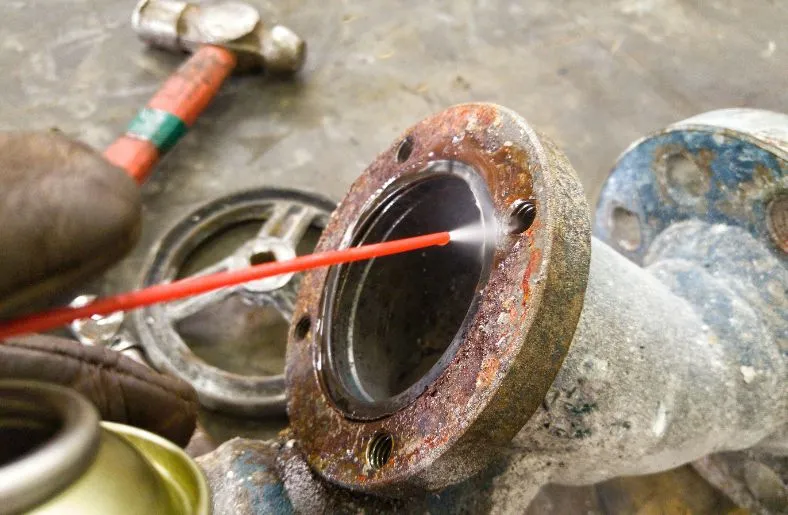As a homeowner or DIY enthusiast, you’ve likely come across WD-40 at some point. It’s a staple in many toolboxes, known for its ability to loosen rusted bolts and silence squeaky hinges. But have you ever wondered if WD-40 is more than just a lubricant?
In this article, I will delve into the versatility of WD-40 and whether is WD-40 a degreaser and explore whether it can be considered much more.
Table of Contents
Role of Degreasers
Before we dive into the specifics of WD-40 and whether is WD-40 a degreaser, let’s first understand what a degreaser is and its purpose. A degreaser is a chemical solvent designed to remove grease, oil, and other stubborn residues from various surfaces.
It’s commonly used in automotive, industrial, and household applications. Degreasers are particularly useful for removing grease buildup on engines, tools, and kitchen appliances, among other things.
Applications of Degreasers
Industrial Use
- Automotive: Degreasers are used to remove oil and grease from engines, machinery, and vehicle parts, ensuring optimal performance and longevity.
- Manufacturing: Industrial degreasers are employed to clean equipment, conveyor belts, and workspaces, promoting efficiency and compliance with safety standards.
- Food Service: In commercial kitchens, degreasers are indispensable for cleaning ovens, grills, countertops, and floors, preventing cross-contamination and maintaining sanitation.
Household Use
- Kitchen Cleaning: Degreasers effectively remove grease buildup on stovetops, range hoods, and countertops, keeping the kitchen clean and hygienic.
- Outdoor Cleaning: From BBQ grills to patio furniture, degreasers help eliminate grease and oil stains, restoring outdoor surfaces to their pristine condition.
- Garage and Workshop: Degreasers are handy for cleaning tools, garage floors, and workbenches, facilitating maintenance tasks and enhancing safety
What is WD-40 and its Primary Uses
WD-40 is a multi-purpose lubricant and penetrating oil that has been around since 1953. Its name is derived from “Water Displacement, 40th formula,” as it was the result of the 40th attempt to create a rust-prevention solvent.
WD-40 is primarily known for its ability to lubricate moving parts, loosen rust, and displace moisture. It’s typically packaged in an aerosol can for easy application.
Is WD-40 a Degreaser?
Now, let’s address the burning question: is WD-40 a degreaser? The answer is both yes and no. While WD-40 does have some degreasing properties, it’s not specifically formulated as a heavy-duty degreaser. It can effectively remove light grease and grime, but for more stubborn or heavy grease buildup, you may need a dedicated degreaser.
However, WD-40 can certainly be a handy tool for quick degreasing tasks, especially in a pinch.
The Versatility of WD-40 Beyond Degreasing
Is WD-40 a degreaser? As mentioned above WD-40 may not be a dedicated degreaser, its versatility extends far beyond that. Let’s explore some of the other practical uses of WD-40:
WD-40 as a Lubricant and Rust Preventer
One of the primary uses of WD-40 is as a lubricant. Its low viscosity allows it to penetrate tight spaces and provide long-lasting lubrication for moving parts. From squeaky hinges to stubborn locks, WD-40 can help eliminate friction and extend the lifespan of mechanical components.
Additionally, WD-40 serves as an excellent rust preventer. Its ability to displace moisture and create a protective barrier makes it ideal for preventing rust and corrosion on metal surfaces. By applying a thin coat of WD-40 to tools, outdoor furniture, or even bike chains, you can help keep them in optimal condition.
Related Guide: How to Fix a KitchenAid Mixer Grease Leak (2024)? A Guide
Other Practical Uses of WD-40
Apart from its lubricating and rust-preventing properties, WD-40 has a myriad of other practical uses. Here are a few examples:
- Removing adhesives: WD-40 can effectively dissolve adhesives, making it easier to remove stickers, tape residue, or gum from various surfaces.
- Cleaning and polishing: WD-40 can be used to clean and polish chrome, stainless steel, and other metal surfaces. Its gentle formulation helps remove dirt and grime without causing damage.
- Unsticking zippers: If you’ve ever struggled with a stuck zipper, a little bit of WD-40 can work wonders. Simply spray it along the zipper track and gently work the zipper back and forth until it loosens up.
Tips for Using WD-40 Effectively
To make the most of WD-40, here are some tips to keep in mind:
- Use in well-ventilated areas: WD-40 contains chemical solvents, so it’s important to use it in a well-ventilated area or outdoors to avoid inhaling fumes.
- Test on a small, inconspicuous area: Before using WD-40 on a delicate or sensitive surface, it’s always a good idea to test it on a small, inconspicuous area to ensure it doesn’t cause any damage or discoloration.
- Apply sparingly: A little goes a long way with WD-40. Apply it sparingly to avoid excess residue or buildup.
Comparing WD-40 to Other Degreasers
While WD-40 has some degreasing capabilities, it’s worth comparing it to other dedicated degreasers to understand its limitations. Heavy-duty degreasers, such as citrus-based cleaners or industrial-strength solvents, are specifically designed to tackle tough grease and grime.
If you’re dealing with stubborn or heavy buildup, it’s best to opt for a degreaser specifically formulated for such tasks. However, for light degreasing and general maintenance, WD-40 can be a convenient and effective solution.
Conclusion
Is WD-40 a degreaser or not? The answer is that it may not be a dedicated degreaser, it certainly possesses degreasing properties that make it useful for light grease and grime removal. However, its versatility extends beyond degreasing.
WD-40 serves as a lubricant, rust preventer, adhesive remover, and cleaning agent, among other things. Its ability to tackle various tasks makes it a valuable addition to any toolbox or household. So, the next time you reach for WD-40, remember its multi-purpose wonder and all the tasks it can help you accomplish.
Now that you understand the versatility of WD-40, why not give it a try on your next project? Whether it’s lubricating a squeaky door hinge or removing sticker residue, WD-40 is a handy tool to have around. Experiment with its different uses and discover just how versatile this iconic product can be.

